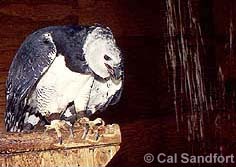The animal climbs down from the canopy, excavates a small depression at the foot  of the tree, voids its feces, and then returns back up. Mites, beetles, and even a few species of moth leap off the sloth, deposit an egg in the dung, and climb back onto their host for a ride up the tree. The eggs germinate, and in one way or another, the young insects find another sloth to call home. of the tree, voids its feces, and then returns back up. Mites, beetles, and even a few species of moth leap off the sloth, deposit an egg in the dung, and climb back onto their host for a ride up the tree. The eggs germinate, and in one way or another, the young insects find another sloth to call home.
 Why would this animal go down to the base of the tree, exposing itself to all forms of terrestrial predation, when it could just as easily deficate from the treetops?
Why would this animal go down to the base of the tree, exposing itself to all forms of terrestrial predation, when it could just as easily deficate from the treetops? The answer provides an important clue to the immense complexity and subtlety of the Amazonian ecosystem. Biologists have suggested that in depositing feces at the base, the sloth enhances the nutrient regime of the host tree. That such a small amount of nitrogenous material might actually make a difference suggests that this cornucopia of life is far more fragile than it appears. |
 The three-toed sloth is a gentle herbivore. Its slow movements, together with its cryptic coloration, protect it from its major predator, the harpy eagle.
The three-toed sloth is a gentle herbivore. Its slow movements, together with its cryptic coloration, protect it from its major predator, the harpy eagle. 

 of the tree, voids its feces, and then returns back up. Mites, beetles, and even a few species of moth leap off the sloth, deposit an egg in the dung, and climb back onto their host for a ride up the tree. The eggs germinate, and in one way or another, the young insects find another sloth to call home.
of the tree, voids its feces, and then returns back up. Mites, beetles, and even a few species of moth leap off the sloth, deposit an egg in the dung, and climb back onto their host for a ride up the tree. The eggs germinate, and in one way or another, the young insects find another sloth to call home.




